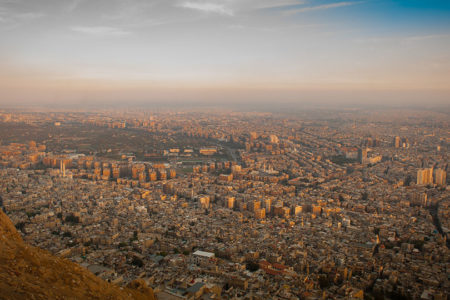Syria: Certain Foe, Uncertain Future
Agatha Christie’s husband, Sir Max Mallowan, was a famous British archaeologist who worked extensive- ly in the Middle East. In her book Come, Tell Me How You Live (Dodd, Mead), Christie describes their travels to Syria in the years before World War II. Among the travelers was an architect dubbed “Bumps,” whose unusual name came about while they were riding in a train:
Bumps pulled up the blind and looked out with interest on the country where the next few months of his life were to be spent.
“Curious place this is,” he remarks. “It’s all over bumps!”
“Bumps, indeed!” cries the Colonel. “Don’ t you realize, you irreverent fellow, that each of those bumps is a buried city dating back thousands of years?”
To understand present-day Syria involves understanding the “bumps” of its past.
Its Varied History
The Biblical Period. The biblical region of Syria included the land north and east of Israel, reaching into what is known as Mesopotamia. The Hebrew name was Aram, and the people were Arameans. Jacob fled to this area and found his uncle and the women who would become his wives (Gen. 28—31). Years later the kings of Damascus (the capital of Aram) attacked the kingdoms of Israel and Judah. The wellknown account of Naaman in 2 Kings 5 describes the conversion and healing of a great Syrian (Aramean) general.
During the Babylonian Captivity, Ezekiel described Israel’s future kingdom as extending farther to the north than its historical borders, encompassing several Syrian cities (Ezek. 47:15–18). God already had promised the area to the Israelites (Ex. 23:31; Dt. 11:24). The Babylonians, Persians, and Greeks later conquered Syria. Rome subjugated the western part of Syria in 64 B.C. The New Testament describes how Paul was in Damascus and escaped persecution by being lowered over a wall in a basket (Acts 9:22–25). “The disciples were called Christians first in Antioch,” which was in Syria (Acts 11:26).
The Roman and Islamic Period. Christianity took root in Syria and flourished after Constantine legalized the religion in the Roman Empire in 313. But the 636 invasion of the Islamic Arabs changed Syria and the Middle East. Islam replaced Christianity as the official religion, and Damascus’ Great Mosque was built on the ruins of the Church of Saint John the Baptist. The land continued under Muslim rule until the Crusades. In 1099 the Crusaders incorporated part of Syria into the Latin kingdom of Jerusalem. The attempt was short lived, for the sultan of Egypt, Saladin, conquered the Crusader’s kingdom around 1180 and returned the entire area to Muslim control. Syria faded from importance and lost its final strength when the Mongols invaded in 1260. Later the Ottoman Turks included Syria in their vast kingdom that arose in 1517 and lasted 400 years.
During the First World War, Turkey joined the Central Powers of Germany and Austria-Hungary, which fought against the Allies (Great Britain, France). To gain support against the Turks, the British agreed that, if the Arabs under Turkish domination fought with the Allies, all Arab lands would gain their independence. This promise aided the Allies’ victory, and soon the British and French managed the former Turkish lands (which included Syria) in the Middle East.
The French Period. The League of Nations granted France a temporary mandate in 1920 over the land of Syria and Lebanon. During this time, the modern boundaries were drawn: the northern border with Turkey, the eastern with Iraq, the southern with what is now Jordan and Israel, and the western with Lebanon and the Mediterranean Sea. French oversight continued (with much Syrian resentment) until after World War II. France agreed to Syrian independence in 1941, but French influence continued to prevent self-determination. Finally the Syrians asserted themselves, forced the French out, and became a charter member of the United Nations. The recurrence of other nations’ claims to Syria’s land finally stopped—no longer would it be “an imperial doormat.”
The Modern Period. The independent nation of Syria was created in 1946 when the French totally withdrew after their 26-year stay. Now officially called the Syrian Arab Republic, Syria began its rocky road to statehood. Within the first 10 years, numerous governments came and went under at least five military coups. During the mid-1950s, Syria found an ally in the Soviet Union, which promised massive funding for military and civilian projects. Beginning in 1958, Syria formed an alliance with Egypt. This federation, headed by Gamal Abdel Nasser, then president of Egypt, was called the United Arab Republic (UAR). However, after unpopular attempts at socialism, the Syrian army ousted the Egyptians and declared Syrian independence in 1961.
It was then the Baath Party (or the Arab Socialist Renaissance Party) came to power. Again political intrigue and military coups reigned. In 1970 Defense Minister Hafez al-Assad usurped total power and, the next year, was elected president. The people of Syria had experienced 21 military coups from the time of their country’s independence until Assad’s takeover. His background was Alawite, an offshoot of Islam that both the traditional Sunni and Shiite Muslims view with suspicion. He continued as president, or “dictator,” until his death in 2000. His son Bashar now occupies that office.
About 18 million people live in the land that covers some 70,000 square miles. The two largest cities are Halab (also known as Aleppo, population about 2 million) and the capital city, Damascus (population about 4 million to 6 million). Most Syrians are Arabs, but the largest minorities are Kurds and Armenians. Other ethnicities include Druze (a mystical Muslim offshoot), Turks, Circassians, Assyrians, and Jews. Syria also has about 300,000 Palestinian refugees.
The Syrians are almost exclusively Muslim. The Sunni branch of Islam represents 73 percent of the population, with Shiite, Alawite, and other Muslim factions at 13 percent. Christians (Orthodox, Roman Catholic, and Protestant) account for 10 percent, and Druze represent 3 percent. The tiny Jewish population now numbers about 150 people, down from 4,500 in the 1990s.
Its Vitriolic Hatred
As Seen in Wars. Political dissent in Syria is forbidden. Martial law has been in place since 1963 to stem internal dissent. When Hafez al-Assad ran for his last seven-year term of presidency, he was undefeated—he ran unopposed.
A good illustration of Assad’s ruthlessness involves the Muslim Brotherhood. The rebels sought to replace Assad’s government with an Islamic one. After numerous provocations over two years, Assad decided to make an example of them. In 1982 government troops massacred their stronghold in the city of Hamah. Witnesses claim that between 10,000 to 30,000 of the city’s 200,000 residents were exterminated. The incident may reflect Assad’s personal history. As a young student in 1948, Assad was stabbed numerous times in the back by Muslim Brotherhood activists. His body recovered from the attack, but he may never have recovered from the attackers.
Syria’s neighbor Lebanon also has felt Assad’s iron fist. His forces have occupied Lebanon since the mid-1970s. In 1991 the Syrian and Lebanese forces signed a friendship treaty that included about 50,000 troops in Lebanon. Whether or not these troops remain, Syria’s strong tentacles may always be present.
In the eyes of the United States, one word characterizes Syria—terrorism. Syria has been on the U.S. list of sponsors of terrorism since its inception. The U.S. State Department states,
Concern remains over the continuing presence of terrorist groups in Syria and Syrian-controlled areas of Lebanon, Syria’ s human rights record, and Syrian involvement in narcotics activity in Lebanon. Syria’ s relations with Western nations were particularly strained in the past decade because of Syrian support for groups involved in international terrorism, including the Popular Front for the Liberation of Palestine-General Command, the Palestine Islamic Jihad, the Abu Nidal Organization, [and] Hizballah.
This last group is an Iranian-backed militia that uses Lebanon’s close border with Israel to stage rocket attacks into Jewish population centers. Recently it captured Israeli soldiers and mocked the peace process and cease-fire agreements.
While terrorism is Syria’s blood sport, another pastime has become an addiction—hatred of Israel. Syria is one of the bitterest enemies of the State of Israel. The two countries have fought in Israel’s three major wars: the War of Independence (1948), the Six-Day War (1967), and the Yom Kippur War (1973). Syria’s loss of the Golan Heights in the Six-Day War remains a thorn in its side. It was from these high mountains near the Sea of Galilee that the Syrians shelled Israeli villages without provocation for 20 years. Elie Cohn, the late master spy for Israel, provided the key to Israel’s victory against Syria. The Golan Heights are considered an indispensable part of Israel’s defense.
A state of war between the countries continues to this day, as illustrated in the U.S. State Department’s warning: “Travelers with Israeli stamps in their passports . . . or cachets from other countries that suggest prior travel to Israel will cause Syrian immigration authorities to refuse the traveler admission to Syria.” This vitriolic hatred for Israel manifests itself in Syria’s outright denial of Israel’s existence. The Syrian press avoids the name Israel and substitutes “the Zionist entity,” “the enemy,” or “occupied Palestine.” Such propaganda displays a desire to avoid even pronouncing the name of Israel and refusing to recognize its right to exist.
As Seen in Peace. As an aftermath of the 1991 Gulf War, many Arab countries began peace talks with Israel. These produced the 1993 Oslo agreements that declared peace between Israel, the Palestine Liberation Organization (PLO), and Jordan. At the same time, secret talks with Syria were underway in hopes of securing a true peace between Israel and its northern neighbor. (Syria had joined the United States in 1991 to fight Iraq’s Saddam Hussein.)
With the breakdown of the Soviet Union’s support, the clever Assad needed to reposition himself on the world scene. So he turned “peace maker.” However, as a precondition to discussions with Israel, Assad demanded Israel return the Golan Heights captured in 1967. He refused to compromise. Talks between the two countries reached a standstill under Israeli Prime Minister Benjamin Netanyahu. But in 1999, Israel’s next prime minister, Ehud Barak, resumed peace talks.
However, not even pressure from U.S. President Bill Clinton could revive Assad’s interest in making peace with his most bitter enemy. As one Syrian intellectual said of the situation, “War is suicide, but peace is surrender.” Two months later, in June 2000, Assad died.
Assad’s son Bashar, a London-trained eye doctor, quickly was elected the next president. Observers wonder if he represents hope for peace or a return to his father’s hard line. His recent statements align him with his father. Addressing the nation at his inauguration, he said Syria must continue “rejecting Zionist existence in all its forms and we say to them [former Syrian residents of the Golan Heights] we are with you and our steadfastness together is the guarantee that our land will be liberated.”
When Pope John Paul II visited Syria in 2001, Bashar’s words provoked international rage. He said, “The Jews who tortured the early Christians are now torturing the Palestinian people”; and the Jews “tried to kill the principles of all religions with the same mentality in which they betrayed Jesus Christ and the same way they tried to betray and kill the Prophet Muhammad.”
Syria remains a certain foe with an uncertain future.







